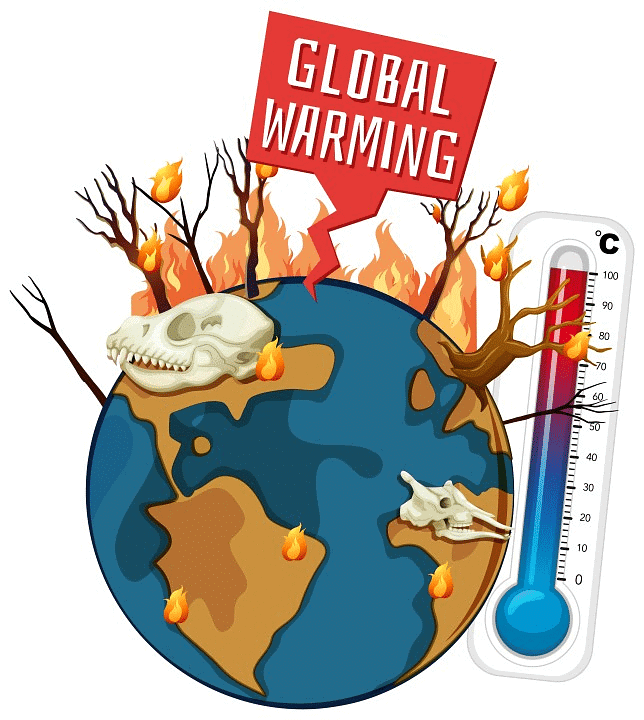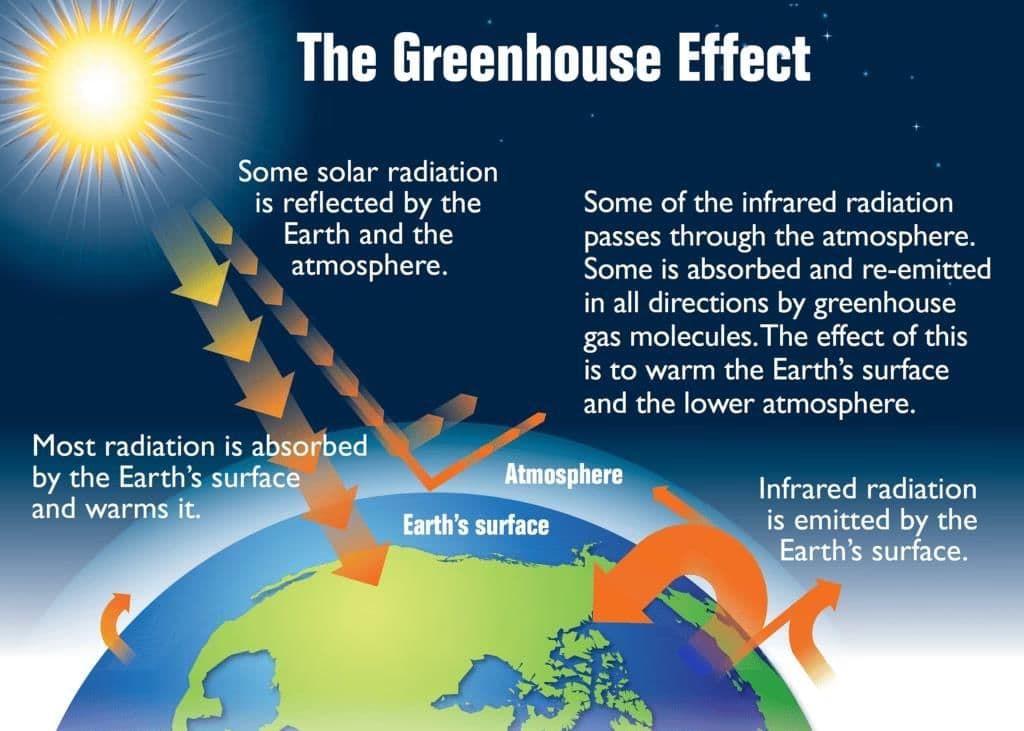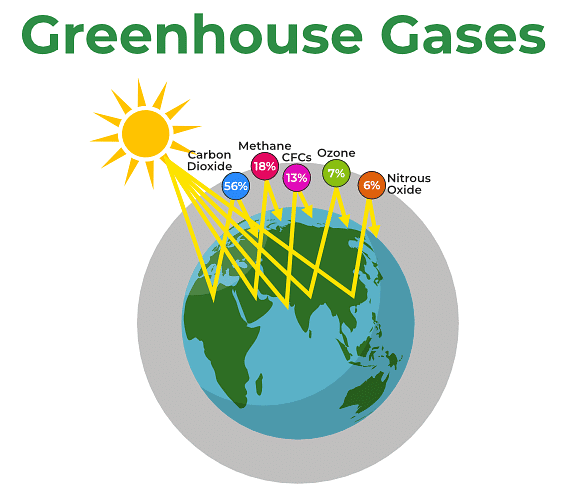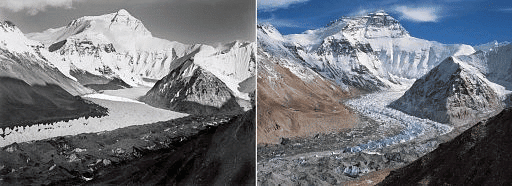Shankar IAS Summary: Climate Change | Famous Books for UPSC Exam (Summary & Tests) PDF Download
Introduction
Global warming, a critical environmental issue, has surged in significance with an unprecedented rise in Earth's temperature over the last century, particularly in the past two decades. Each year since 1992, including the record-setting 2016, has marked among the warmest globally. Driven by increased greenhouse gas emissions, global warming poses multifaceted challenges, from melting polar ice caps to altered weather patterns. This concise overview emphasizes the urgency of addressing this complex phenomenon in the current environmental discourse.
Global Warming
Earth has experienced an unprecedented warming trend over the past century, with a notable acceleration in the last two decades. Since 1992, each year has consistently ranked among the warmest on record. 2016 holds the record as the hottest year globally. This warming trend is associated with a surge in extreme weather events such as wildfires, heatwaves, and intense tropical storms.

Global warming is characterized by an average increase in the temperature of the Earth's surface and troposphere, contributing to shifts in global climate patterns. It can result from various factors, both natural and human-induced. In everyday language, "global warming" often refers to temperature rise caused by increased greenhouse gas emissions from human activities.
Global Warming - Impacts
- Rise in Sea Level:
- Changes in Rainfall Patterns:
- Increased Likelihood of Extreme Events: Such as heatwaves, flooding, hurricanes, etc.
- Melting of the Ice Caps:
- Melting of Glaciers:
- Widespread Vanishing of Animal Populations: Due to habitat loss.
- Spread of Disease: Such as malaria, etc.
- Bleaching of Coral Reefs:
- Loss of Plankton: Due to warming of seas.
Greenhouse Effect
- The greenhouse effect is a naturally occurring phenomenon that blankets the earth loweratmosphere and warms it maintaining the temperature suitable for living things to survive.
- Water vapour and greenhouse gases warms the Earth.

(i) Incoming Energy
- The Sun emits energy that is transmitted to Earth.
- Because the Sun is very hot, the energy is emitted in high-energy short wavelengths that penetrate the Earth’s atmosphere.
(ii) Absorption
About 30% of the Sun's energy is reflected directly back into space by the atmosphere, clouds, and surface of the Earth. The rest oi the Sun’s energy is absorbed into the Earth's system (70%)
(iii) Emission
The Earth re-emits energy back into the atmosphere. Because the Earth is cooler than the Sun, the energy is emitted in the form of infrared radiation, at wavelengths longer than the incoming solar energy.
(iv) Role of Greenhouse Gases
Greenhouse gases in the atmosphere absorb much of the long-wave energy (infrared radiation) emitted from the Earth's surface, The greenhouse gases then re-emit this energy in all directions, warming the Earth's surface and lower atmosphere.
Green House Gases
Greenhouse gases" means those gaseous constituents of the atmosphere, both natural and anthropogenic, those absorbs and re-emit infrared radiation.

(i) Water Vapour
- The biggest overall contributor to the greenhouse effect and humans are not directly responsible for emitting this gas in quantities sufficient to change its concentration in the atmosphere.
- CO2 and other greenhouse gases is increasing the amount of water vapour in the air by boosting the rate of evaporation.
(ii) Carbon Dioxide
The main sources
- The combustion of fossil fuels to generate electricity.
- The combustion of fossil fuels such as gasoline and diesel used for transportation
- Many industrial processes emit CO2 through fossil fuel combustion
- Several processes also produce CO2 emissions through chemical reactions that do not involve combustion.
- Reducing Carbon Dioxide Emissions
(a) The most effective way to reduce carbon dioxide (CO2) emissions is to reduce fossil fuel consumption.
(b) Other strategies include Energy Efficiency, Energy Conservation, Carbon Capture and Sequestration.
(iii) Methane
- (CH4) is emitted by natural sources such as wetlands, as well as human activities such as leakage from natural gas systems and the raising of livestock.
- Natural processes in soil and chemical reactions in the atmosphere help remove CH4 from the atmosphere
- Human induced:
(i) Agriculture: Domestic livestock such as cattle, buffalo, sheep, goats, and camels produce large amounts of CH4 as part of their normal digestive process.
(ii) Globally, the Agriculture sector is the primary source of CH4 emissions Methane is the primary component of natural gas.
(iii) Some amount of, CH4 is emitted to the atmosphere during the production, processing, storage, transmission, and distribution of crude oil & natural gas.
(iv) Nitrous Oxide
- (N2O) is naturally present in the atmosphere as part of the Earth's nitrogen cycle, and has a variety of natural sources.
- Natural emissions of N2O are mainly from bacteria breaking down nitrogen emitted when people add nitrogen to the soil through the use of synthetic fertilizers, also emitted during the breakdown of nitrogen in livestock manure and urine, which Contributed to 6% of N2O emissions in 2010 emitted when transportation fuels are burned generated as a by-product during the production of nitric acid,
- Which is used to make synthetic commercial fertilizer, and in the production of adipic acid, which is used to make fibers, like nylon, and other synthetic products. Removed from the atmosphere when it is absorbed by certain types of bacteria or destroyed by ultraviolet radiation or chemical reactions.
(v) Fluorinated Gases
- They are emitted through a variety of industrial processes such as aluminium and semiconductor manufacturing & Substitution for Ozone-Depleting Substances.
- Very high global warming potentials (GWPs) relative to other greenhouse gases, well-mixed in the atmosphere, spreading around the world after they're emitted.
- Removed from the atmosphere only when they are destroyed by sunlight in the far upper atmosphere, the most potent and longest lasting type of greenhouse gases emitted by human activities.
(a) Hydro fluorocarbons (HFCs),
(b) Per fluorocarbons (PFCs), and
(c) Sulphur hexafluoride (SF6). - Hydro fluorocarbons are used as refrigerants, aerosol propellants, solvents, and fire retardants
- These chemicals were developed as a replacement for chlorofluorocarbons (CFCs) and hydro chlorofluoro carbons (HCFCs) because they do not deplete the stratospheric ozone layer.
- Unfortunately, HFCs are potent greenhouse gases with long atmospheric lifetimes and high GWPs, Per fluorocarbons are compounds produced as a by-product of various industrial processes associated with aluminium production and the manufacturing of semiconductors.
- Like HFCs, PFCs generally have long atmospheric lifetimes and high. GWPs. Sulfur-hexafluoride is used in magnesium processing and semiconductor manufacturing, as well as a tracer gas for leak detection. Sulphur hexafluoride is used in electrical transmission equipment, inducing circuit breakers.
(vi) Black Carbon
- Commonly known as soot, is a form of particulate air pollutant, produced from incomplete combustion, consists of pure carbon in several linked forms.
- A solid particle or aerosol, (though not a gas) contributes to warming of the atmosphere, bio mass burning, cooking with solid fuels, diesel exhaust, etc warms the Earth by absorbing heat in the atmosphere and by reducing albedo, ( the ability to reflect sunlight) when deposited on snow and ice.
- The strongest absorber of sunlight and heats the air directly, it darkens snow packs and glaciers through deposition and leads to melting of ice and show.
- Disrupts cloudiness and monsoon rainfall and accelerates melting of mountain glaciers such as the Hindu Kush-Himalayan glaciers
(vii) Brown Carbon
A ubiquitous and unidentified component of organic aerosol which has recently come into the forefront of atmospheric research. Light-absorbing organic matter (other than soot) in atmospheric aerosols of various origins, e.g., soil humics, humic-like substances (HLTLIS), tarry materials from combustion, bio aerosols.
Climate Forcings
- Are factors in the climate system that either increase or decrease the effects to the climate system.
- Positive forcing such as excess greenhouse gases warm the earth negative forcing, such as the effects of most aerosols and volcanic eruptions, actually cool the earth.

Natural Forcing's
Include changes in the amount of energy emitted by the Sun, very slow variations in Earth’s orbit, and volcanic eruptions
Human-Induced Forcing's
- Activities include greenhouse gas and aerosol emissions from burning fossil fuels and modifications of the land suface, such as deforestation Greenhouse gases are a positive climate forcing; that is, they have a warming effect
- Carbon dioxide emitted from the burning of fossil fuel is presently the largest single climate forcing agent, accounting for more than half of the total positive forcing since 1750 Burning fossil fuels adds aerosols to the atmosphere.
- Aerosols are tiny particles in the atmosphere composed of many things, including water, ice, ash, mineral dust, or acidic droplets.
- Aerosols can deflect the Sun’s energy and impact the formation and lifetime of clouds. Aerosols are a negative forcing; that is, they have a cooling effect.
Estimate the effect of each gas ( three main factors)
- How much of these gases are in the atmosphere
- How long do they stay in the atmosphere
- How strongly do they impact global temperatures
Global Warning Potential

- The Global Warming Potential (GwP) for a gas is a measure of the total energy that a gas absorbs over a particular period of time (usually 100 years), compared to carbon dioxide, lower GWP, and thus contribute more to warming Earth. Scale
- Gases with a higher GWP absorb more energy, per pound, than gases with a Methane (CH4) hasa GWP more than 20 times higher than CO2 for a 100-year time Nitrous Oxide ( N2O) has a GWP 300 times that of CO2 for a 100-year timescale
- Chloro fluoro carbons (CFCs), hydro fluoro carbons (HFCs), hydro chloro fluoro carbons (HCFCs), perfluoro carbons (PFCs), and sulfur hexafluoride (SF6) are called high-GWP
Receding Glaciers-A Symptom of Global Climate Change
Over the past 150 years, Glacier National Park has witnessed a significant decline in glaciers, dropping from 147 to only 37 today. Scientists project that these remaining glaciers are likely to melt by 2030, mirroring a global trend observed in the Himalayas and Alps. The use of satellite remote sensors has become crucial for efficiently monitoring the approximately 160,000 glaciers in Polar Regions and high mountain environments.

Impact of Glacial Retreat
- Water Supplies: The retreat of glaciers in the Andes and Himalayas poses a potential threat to water supplies.
- Climate Change Effects: Variations in temperature and snowfall, altering the mass balance of glaciers, are attributed to climate change.
- Regional Impact: The glaciated mountain chains, like the Himalayas, play a crucial role in supplying water to dry countries such as Mongolia, western China, Pakistan, and Afghanistan. The loss of these glaciers would significantly impact the region's ecosystem.
- Global Warming Concerns: Leading scientists warn that global warming poses a serious threat to the national and global economy, as well as the environment.
- Challenges for Vulnerable Countries: Poor and low-lying countries will face difficulties coping with the damages caused by changing climate and rising sea levels.
Climate Tipping
Climate Tipping Points (CTPs): Indicators within the broader climate system, CTPs, when surpassed, trigger self-sustaining warming, leading to cascading effects.
Global Heating Impact: Human-induced global heating by 1.1 degrees Celsius may have already crossed five critical tipping points, including the potential collapse of the Greenland ice cap, disruption of the North Atlantic current crucial for rainfall, and permafrost thawing rich in carbon.
15 Degrees Celsius Threshold: At 15 degrees Celsius, five possible tipping points emerge, affecting northern forests, mountain glaciers, tropical coral reefs, and the West African monsoon.

2°C Temperature Rise: Nine global tipping points, such as the collapse of ice sheets in Greenland, West Antarctic, East Antarctic, and the potential disruption of the Atlantic Meridional Overturning Circulation (AMOC), are identified when temperatures rise beyond 2°C. Risks also include Amazon dieback, permafrost collapse, and Arctic winter sea ice loss.
Ongoing Research: Current research explores potential tipping points like ocean oxygen loss and significant changes in the Indian summer monsoon.
Recent Developments
Latest IPCC Findings:
- The IPCC AR6 Synthesis Report released in March 2023 consolidates all three Working Group reports and special studies, warning that the global average temperature is already about 1.1°C higher than pre-industrial levels. The report stresses that without deep and immediate cuts to greenhouse gas emissions, the 1.5°C limit will be breached in the next decade.
- It emphasises accelerating risks such as ecosystem collapse, food insecurity, and compounding hazards from simultaneous extreme events.
Recent Extreme Weather Events in India and Globally:
- The 2025 India–Pakistan heatwave (April–May) saw record temperatures exceeding 48°C in parts of Rajasthan, Punjab, and Sindh, causing hundreds of deaths and large-scale health emergencies.
- Cloudburst and flash floods in Uttarakhand (July 2025) destroyed several villages, highlighting the link between climate change and increased frequency of high-intensity rainfall events.
- Implementation of AI-based heat vulnerability mapping in Indian cities (e.g., Delhi’s ward-level Heat Action Plan) is now aiding targeted interventions for heat-stressed populations.
Energy Transition Milestones:
- India achieved its 50% installed power capacity from non-fossil sources target (set under the Paris Agreement) ahead of the 2030 deadline in early 2025. However, coal remains the dominant source in terms of actual generation.
- Rapid expansion of solar parks, offshore wind pilot projects, and green hydrogen missions is contributing to emission reduction goals.
Climate Finance and Policy Updates:
- In May 2025, the Government of India released a Draft Climate Finance Taxonomy to guide and mobilise investments toward mitigation and adaptation projects, ensuring consistency with national climate goals.
- The Reserve Bank of India (RBI) announced climate-risk disclosure norms for banks, voluntary from FY 2027 and mandatory from FY 2028, to strengthen the financial sector’s resilience to climate shocks.
- India’s first CO₂ storage well project was initiated by IISER Bhopal in 2025, marking a breakthrough in domestic carbon capture and storage (CCS) technology.
Adaptation and Resilience Initiatives:
- India is set to submit its National Adaptation Plan (NAP) to the UNFCCC by September 2025, building on the earlier National Action Plan on Climate Change (NAPCC) and focusing on water security, agriculture, and climate-resilient infrastructure.
- The World Bank estimates that India will require about $2.4 trillion by 2050 to build climate-resilient infrastructure, emphasising the urgent need for blended finance models and public–private partnerships.
- States are increasingly adopting parametric climate insurance schemes to protect farmers and vulnerable communities from losses due to climate extremes.
Glacier and Cryosphere Updates:
- Himalayan glaciers continue to retreat at accelerated rates, with recent ISRO and ICIMOD studies showing an average loss of 0.6 metres water equivalent per year over the last decade, posing risks to water supply in the Indo-Gangetic basin.
- Risk of glacial lake outburst floods (GLOFs) has increased, prompting MoEFCC to expand early warning networks in high-risk valleys.
Climate Tipping Points – New Research:
- Updated research in 2024–25 suggests that warming beyond 1.5°C could trigger irreversible loss of the West Antarctic Ice Sheet and large-scale dieback of the Amazon rainforest sooner than previously predicted.
- Potential new tipping elements under study include ocean deoxygenation and long-term weakening of the Indian Summer Monsoon.
|
743 videos|1444 docs|633 tests
|
FAQs on Shankar IAS Summary: Climate Change - Famous Books for UPSC Exam (Summary & Tests)
| 1. What is the greenhouse effect? |  |
| 2. How do greenhouse gases contribute to global warming? |  |
| 3. What are climate forcings and how do they impact the Earth's climate? |  |
| 4. How do receding glaciers serve as a symptom of global climate change? |  |
| 5. What is the Global Warming Potential (GWP) and how is it calculated? |  |

















